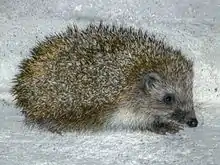قنفذ
Arabic

Alternative forms
- قُنْفُد (qunfud)
Etymology
Considering the spirantization of the final consonant, and the occasional variation of the second syllable with fatḥa, borrowed from Aramaic קֻפְדָּא / קוּפְּדָּא (qupdā) / ܩܽܘܦܕܳܐ (quppəḏā), which in Classical Mandaic is written out ࡒࡅࡍࡐࡅࡃ (qunpud), as also in Samaritan Aramaic ࠒࠍࠐࠃ (qnfd) beside ࠒࠐࠃ (qfd), also likely the source of Hebrew קִפּוֹד (qippṓḏ), all meaning hedgehog. Compare Arabic خُنْفُس (ḵunfus, “beetle”) as a borrowing with a similar form, where the main Aramaic dialects do not display the /n/ insertion.
Related to meanings of the root ק־פ־ד / ܩ-ܦ-ܕ (q-p-d) / ق ف د (q-f-d) “to be wrinkled, to be twisted up, to wind, to roll entirely round”.
Noun
قُنْفُذ • (qunfuḏ) m (plural قَنَافِذ (qanāfiḏ), feminine قُنْفُذَة (qunfuḏa))
- hedgehog
Declension
| Singular | basic singular triptote | ||
|---|---|---|---|
| Indefinite | Definite | Construct | |
| Informal | قُنْفُذ qunfuḏ | الْقُنْفُذ al-qunfuḏ | قُنْفُذ qunfuḏ |
| Nominative | قُنْفُذٌ qunfuḏun | الْقُنْفُذُ al-qunfuḏu | قُنْفُذُ qunfuḏu |
| Accusative | قُنْفُذًا qunfuḏan | الْقُنْفُذَ al-qunfuḏa | قُنْفُذَ qunfuḏa |
| Genitive | قُنْفُذٍ qunfuḏin | الْقُنْفُذِ al-qunfuḏi | قُنْفُذِ qunfuḏi |
| Dual | Indefinite | Definite | Construct |
| Informal | قُنْفُذَيْن qunfuḏayn | الْقُنْفُذَيْن al-qunfuḏayn | قُنْفُذَيْ qunfuḏay |
| Nominative | قُنْفُذَانِ qunfuḏāni | الْقُنْفُذَانِ al-qunfuḏāni | قُنْفُذَا qunfuḏā |
| Accusative | قُنْفُذَيْنِ qunfuḏayni | الْقُنْفُذَيْنِ al-qunfuḏayni | قُنْفُذَيْ qunfuḏay |
| Genitive | قُنْفُذَيْنِ qunfuḏayni | الْقُنْفُذَيْنِ al-qunfuḏayni | قُنْفُذَيْ qunfuḏay |
| Plural | basic broken plural diptote | ||
| Indefinite | Definite | Construct | |
| Informal | قَنَافِذ qanāfiḏ | الْقَنَافِذ al-qanāfiḏ | قَنَافِذ qanāfiḏ |
| Nominative | قَنَافِذُ qanāfiḏu | الْقَنَافِذُ al-qanāfiḏu | قَنَافِذُ qanāfiḏu |
| Accusative | قَنَافِذَ qanāfiḏa | الْقَنَافِذَ al-qanāfiḏa | قَنَافِذَ qanāfiḏa |
| Genitive | قَنَافِذَ qanāfiḏa | الْقَنَافِذِ al-qanāfiḏi | قَنَافِذِ qanāfiḏi |
Descendants
- Maltese: qanfud
- Moroccan Arabic: قنفود (qanfūd)
- → Amharic: ቅንፍዝ (ḳənfəz)
- → Beja: kunfed
- → Ge'ez: ቍንፍዝ (ḳʷənfəz), ቅንፍዝ (ḳənfəz), ቅንፉዝ (ḳənfuz)
- → Saho: qunfid
- → Tigre: ቅንፍዝ (ḳənfəz)
- → Tigrinya: ቅንፍዝ (ḳənfəz)
- → Ottoman Turkish: قنفذ (kunfuz)
References
- “qwpd2”, in The Comprehensive Aramaic Lexicon Project, Cincinnati: Hebrew Union College, 1986–
- “qwpdˀ”, in The Comprehensive Aramaic Lexicon Project, Cincinnati: Hebrew Union College, 1986–, an owl
- “qpwp”, in The Comprehensive Aramaic Lexicon Project, Cincinnati: Hebrew Union College, 1986–, an owl
- “qpd”, in The Comprehensive Aramaic Lexicon Project, Cincinnati: Hebrew Union College, 1986–
- Militarev, Alexander; Kogan, Leonid (2005) Semitic Etymological Dictionary, volume II: Animal Names, Münster: Ugarit-Verlag, →ISBN, pages 181–183, Nr. 133, where they do not dare to gloss Eblaite 𒄀𒁀𒋧 (qi₃-pa₂-šum₂) unlike the other terms. Page LXIV they own that with that the reconstruction of a proto-form becomes impossible.
- Freytag, Georg (1835), “قنفذ”, in Lexicon arabico-latinum praesertim ex Djeuharii Firuzabadiique et aliorum Arabum operibus adhibitis Golii quoque et aliorum libris confectum (in Latin), volume 3, Halle: C. A. Schwetschke, page 507
- Hommel, Fritz (1879) Die Namen der Säugethiere bei den südsemitischen Völkern als Beiträge zur arabischen und äthiopischen Lexicographie, zur semitischen Kulturforschung und Sprachvergleichung und zur Geschichte der Mittelmeerfauna. Mit steter Berücksichtigung auch der assyrischen und hebräischen Thiernamen und geographischen und literaturgeschichtlichen Excursen (in German), Leipzig: J. C. Hinrichs’sche Buchhandlung, page 339
- Lane, Edward William (1863), “قنفذ”, in Arabic-English Lexicon, London: Williams & Norgate, page 2569
- Leslau, Wolf (1982) North Ethiopic and Amharic cognates in Tigre (Supplemento n. 31 al Vol. 42 fasc. 2 (Annali)), Napoli: Istituto universitario Orientale, page 60, where Geʿez, Tigrinya, Tigre, Amharic are declared loanwords from Arabic.
- Leslau, Wolf (1991) Comparative Dictionary of Geʿez (Classical Ethiopic), 2nd edition, Wiesbaden: Otto Harrassowitz, →ISBN, page 434b, where Geʿez, Tigrinya, Tigre, are declared loanwords from Arabic, and the roll-up derivation is recognized.
- Růžička, Rudolf (1909), “Konsonantische Dissimilation in den semitischen Sprachen”, in Beiträge zur Assyriologie und semitischen Sprachwissenschaft (in German), volume VI, issue 4, Leipzig · Baltimore: J.C. Hinrichs’sche Buchhandlung · The Johns Hopkins Press, page 133, where the roll-up derivation is recognized.
- Wagner, Max (1966) Die lexikalischen und grammatikalischen Aramaismen im alttestamentlichen Hebräisch (Beihefte zur Zeitschrift für die alttestamentliche Wissenschaft; 96) (in German), Berlin: Alfred Töpelmann, →ISBN, page 102, recognizes the roll-up derivation and deems, with reservation because of it being a native animal, the Hebrew word, which also means a bird, borrowed from Aramaic, noting that the correspondence ḏ in Arabic to d in Hebrew and d in Aramaic is only possible by borrowing as inherited *ḏ gives ḏ in Arabic, z in Hebrew, d in Aramaic (ḏ in begedkefet), and indeed Hebrew קִפּוֹז (qippṓz) occurs Isaiah 34,15 as the name of a snake, assumed European whipsnake, Dolichophis jugularis, or alternatively the Eurasian scops owl, Otus scops, or the tawny owl, Strix aluco, derived from קָפַץ (qāfáṣ), قَفَزَ (qafaza, “to jump up”).
- Wahrmund, Adolf (1887), “قنفذ”, in Handwörterbuch der neu-arabischen und deutschen Sprache (in German), volume 2, Gießen: J. Ricker’sche Buchhandlung, page 532a